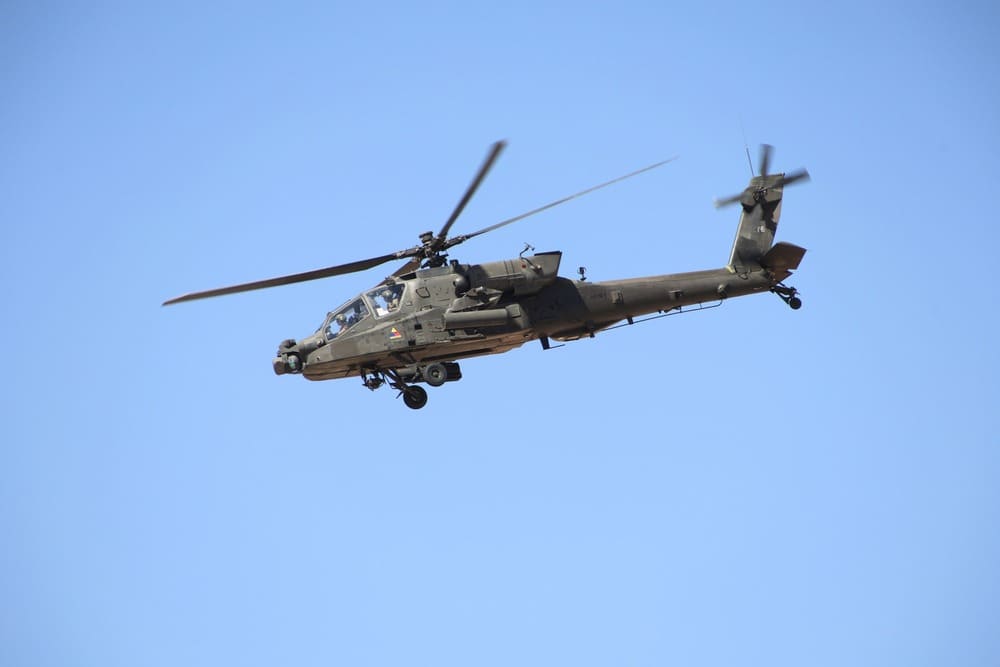Three AH-64D Apache attack helicopters landed this morning at the 56th Air Base in Latkowo, near Inowrocław. They taxied to the ramp in quick succession, rotors still spinning while ground crews signaled them into place. Defense officials confirm these aircraft now belong to the 1st Army Aviation Brigade, a unit that already flies Mi-24 gunships but has never operated an aircraft as advanced as the Apache. The hand-over ceremony stayed low-key, yet the practical effect is clear: Polish pilots can start logging cockpit time right away, instead of waiting until the newer AH-64E Guardians arrive later in the decade. Dutch and Norwegian F-35s deploy to Poland as part of the broader NATO effort to secure eastern supply corridors.
According to industry sources, the lease signed in March covers eight D-model Apaches drawn from U.S. Army inventories. The U.S. side refurbished the airframes, replaced time-expired parts, and shipped the first batch by air to Poznań before road-moving them to Latkowo for re-assembly and test flights. Polish officials confirmed the $300M lease for Apache attack helicopters, which runs through 2028 and covers aircraft, spares, U.S. instructor support, and insurance. The package also includes an initial stock of AGM-114R2 Hellfire missiles and Hydra-70 rockets so crews can practice live-fire without dipping into war-reserve stores.
Poland Signs Lease Deal to Lease Eight U.S. Apache Helicopters
Our analysis shows Poland is using these D-models as a training bridge toward a much larger goal. In August 2024 Warsaw ordered 96 AH-64E Apache Guardian helicopters in a government-to-government deal worth about $10 billion. Deliveries start in 2028 and finish in 2032. By placing leased airframes in service now, the army avoids a cold start and shrinks the training gap. The approach echoes earlier Polish programs that brought leased C-130H transports and K2 tanks online while new production lines spun up.
Latkowo’s flight line needed upgrades before the Apaches could arrive. New power carts, blade-fold stands, and secure avionics bays went in during the spring. Polish maintainers completed airframe familiarization on mock-ups supplied by Boeing and then shadowed U.S. Army technicians during acceptance checks. Defense officials confirm each leased helicopter will fly about 250 hours per year, producing enough sorties to qualify two crews per airframe while respecting fatigue limits on the older machines.
Building Polish Apache Flight Competency Through Interim Training Fleet
The personnel challenge remains significant. Poland currently fields twenty-two Apache-rated pilots—a mix of instructor graduates from Fort Novosel and combat aviators cross-trained from the Mi-24. To sustain a fleet of ninety-six Guardians, the army will need roughly four hundred pilots and more than one thousand technicians. A new personnel policy allows selected non-commissioned officers to apply directly to flight school, expanding the candidate pool without lowering medical or academic standards. Technical training follows a three-block model: basic helicopter systems at the Air Force University in Dęblin, type-specific courses at Latkowo, and on-the-job mentoring with U.S. contract maintainers. Graduates receive NATO-recognized certificates, giving them mobility across allied units for exercises and exchanges.
Financially, the Apache program has two layers. The acquisition contract covers airframes, mission equipment, weapons, and training devices. A separate life-cycle budget allocates about 40 billion PLN for infrastructure, spares, and deep-maintenance capacity over the first eight years. Our analysis shows total program cost across a forty-year life could exceed 100 billion PLN once consumables, engine overhauls, and mid-life sensor upgrades are counted. Parliament’s defense committee earmarked a ten-percent contingency reserve to cushion exchange-rate swings and supply-chain volatility.
Long-Term Investments Anchor Poland Apache Strategy
Industrial cooperation sits at the heart of the offset plan, valued at roughly 1 billion PLN. Wojskowe Zakłady Lotnicze No. 1 (WZL-1) in Łódź will become Poland’s Apache hub. Under the framework, WZL-1 gains tooling for airframe structural repairs by 2029, gearbox and rotor-blade overhaul lines by 2031, and a software lab linked to Boeing’s global sustainment network. According to industry sources, the move creates about six hundred high-skilled jobs and positions Poland as a regional service center for any future NATO Apache operators on the eastern flank.
From a technical standpoint, the AH-64D already offers a jump in capability over legacy gunships. Its AN/APG-78 Longbow radar, perched above the rotor mast, scans through smoke, dust, or fog, ranks targets by threat, and hands the attack queue to the crew in seconds. The D-model’s engines deliver about 1 890 shaft horsepower each, giving hot-and-high performance superior to older Mi-24s. Defensive kit includes a missile warning receiver, infrared jammer, and flare dispensers. Crews sit in armored seats and count on a crash-worthy fuel system.
Enhanced Battlefield Lethality With Apache Capabilities
The future AH-64E Guardians raise the bar further. Defense officials confirm Poland’s E-models will carry T700-701D engines rated at 1 994 shaft horsepower, composite main blades that resist small-arms hits, a strengthened drivetrain, and updated flight controls that boost agility. They will also feature upgraded TADS/PNVS systems tailored to Polish mission requirements. Link 16 and Manned–Unmanned Teaming (MUM-T) links let crews pull live video from UAVs, push target data to artillery batteries, and receive blue-force positions from F-35 fighters. Generation 4 TADS/PNVS sensors give sharper imagery at longer ranges, and software permits target hand-off in less time than earlier blocks.
Offensive punch stays familiar but more flexible. The Hellfire family remains the primary precision weapon, with Poland ordering the multipurpose AGM-114R2 variant that can attack armor, bunkers, or boats. Hydra-70 rockets continue to provide area fire; add-on kits such as APKWS are under review for precision conversion. A 30 mm M230 chain gun rounds out the load, fed by 1 200 rounds and slaved to the gunner’s helmet. The Guardian’s stub wings also accept future air-launched effects or small glide munitions once validated.
Poland Apache Integration Strengthens NATO’s Eastern Flank
Doctrine ties those tools together. Polish planners expect Apaches to operate in mixed detachments with reconnaissance UAVs, artillery, and armored brigades. A typical strike loop starts with a loitering drone finding a column, artillery suppressing air defenses, and Apaches popping up from defilade for a coordinated missile volley. Because the radar and data links shorten kill chains, helicopters spend less time exposed over the line of contact. Crews can pull back behind tree lines or embankments, reload from forward refuel-rearm points, and re-attack within minutes.
Border geography shapes the concept. Poland fronts both Belarus and the Russian exclave of Kaliningrad, leaving little strategic depth. Rapid attack aviation that can shift along road nets and exploit cover complements fixed-wing strike assets that rely on prepared runways. Our analysis shows the Apache’s ability to launch from improvised pads, hop between fuel caches, and feed target data to networked fires fills a gap that legacy platforms could not bridge.
Risk deserves attention. Retaining trained pilots in the face of airline hiring surges remains hard. The army is exploring service-length incentives and sabbatical programs to keep aviators current. Supply-chain friction is another concern; composite rotor blades and radar line-replaceable units have long lead times. Poland’s contingency fund and the standing U.S. support contract reduce but do not eliminate exposure. Finally, exchange-rate shifts can inflate dollar-denominated costs, so the Ministry of Finance locked forward rates for the next three fiscal years.
A clear schedule provides milestones and accountability:
- Q2 2025 – Arrival of first three AH-64D; flight training begins.
- Q3 2025 – Delivery of remaining five leased D-models; squadron forms to full strength.
- 2026 – Initial operating capability declared for the training squadron.
- Q1 2028 – First four AH-64E Guardians accepted; conversion training starts.
- 2030 – Two combat squadrons reach combat readiness with mixed E-model blocks.
- 2032 – Final Guardian delivered; lease ends; D-models returned or parted out.
Poland’s broader defense budget supports the effort. The 2025 allocation stands at 187 billion PLN, well above the NATO 2 percent threshold. Warsaw also promotes a new 3 percent target inside the Alliance, using the Apache fleet as evidence of burden-sharing, along with its new shipment of Abrams tanks and HIMARS launchers. Government officials link the program to future joint ventures with U.S. industry, including possible maintenance support for Ukrainian assets once conditions allow.
Early crew feedback is telling. Instructors praise the Longbow’s automatic threat ranking. Junior pilots mention the display layout that reduces head-down time. Maintainers note clear technical manuals, remote diagnostics, and swift parts shipment through the U.S. Army’s theater warehouse in Germany. Lessons gathered this year will feed directly into Guardian conversion courses, cutting classroom hours and flight checks.
The arrival of the leased Apaches therefore marks more than a ceremonial milestone. It starts a disciplined training rhythm, unlocks infrastructure spending, and gives industry a timeline to build local support lines. Poland’s defense planners measure success not by today’s airframes but by the first day in 2032 when ninety-six Guardians stand ready with full crews, stocked magazines, and homegrown maintenance capacity. Achieving that goal demands constant attention to people, parts, and funding, yet the first three helicopters on the ramp prove the wheel is turning.
REFERENCE LIST
- https://janes.com/osint-insights/defence-news/defence/poland-leases-ah-64d-apaches-to-prepare-for-ah-64e-entry-into-service
- https://armyrecognition.com/news/aerospace-news/2025/poland-strengthens-ground-strike-capabilities-with-arrival-of-first-us-ah-64d-attack-helicopters
- https://breakingdefense.com/2025/03/poland-signs-300m-lease-for-apache-attack-helicopters
- https://defensenews.com/global/europe/2025/02/28/poland-leases-eight-apache-gunships-as-warmup-ahead-of-major-delivery
- https://flightglobal.com/helicopters/poland-signs-lease-agreement-with-us-army-covering-eight-apache-attack-helicopters/162013.article
- https://thedefensepost.com/2025/06/17/poland-apache-helicopters-sensors
- https://militarnyi.com/en/news/poland-receives-first-leased-apache-attack-helicopters



